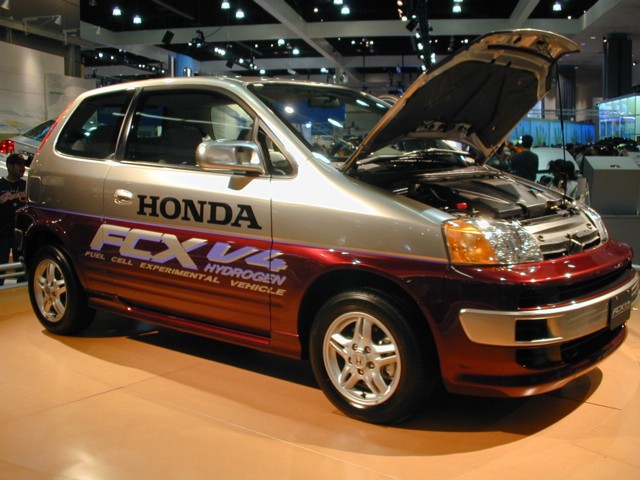
Home - AFV Events - Auto Shows - 2002 L.A. Auto Show
About a year ago, there were a lot more alternative-powered vehicles at the Los Angeles Auto Show in January 2001 than at the Anaheim Auto Show in November 2000. The pattern held true this year; I was quite disappointed by the turnout at the Anaheim Auto Show in October 2001, but this year's Los Angeles Auto Show more than made up for it when my wife and I went there the day it opened to the public, Saturday 5 January 2002.

This is the FCX-V4 (Fuel Cell Experimental Vehicle 4) from Honda; it is a fuel-cell vehicle that runs on hydrogen stored onboard. Like a hybrid-electric vehicle, a fuel-cell vehicle needs some way to store electric power; it doesn't need as much as a battery-electric vehicle, but there has to be some way to store the energy recovered (via "regenerative braking," wherein the electric motor functions as a generator to pull energy out of the forward motion of the vehicle) during deceleration and to keep it in reserve for an extra boost of power beyond what the fuel cell (or gasoline engine, for a hybrid) can supply during hard acceleration. Unlike most other fuel-cell vehicles I've heard about (prototypes and otherwise), the FCX-V4 uses an ultracapacitor instead of a battery pack. Since the energy in a capacitor is stored in the form of electric fields rather than of chemical energy as in a battery, no chemical changes occur during charging and discharging of an ultracapacitor; proponents say this should give it a longer service life than a battery pack as well as the ability to respond faster. If this vehicle looks familiar, it appears to be based on Honda's EV Plus battery-electric vehicle from a few years ago.
Speaking of Honda, this show was the first time I'd seen the hybrid version of their popular Civic sedan, which looks just like their regular ones except for some badging. It has a continuously-variable transmission (CVT) like the one optional in the Insight, and will be out later in 2002. It hasn't completed EPA testing, but Honda estimates 50 MPG fuel economy (compared to 57 city / 56 highway for the CVT Insight).
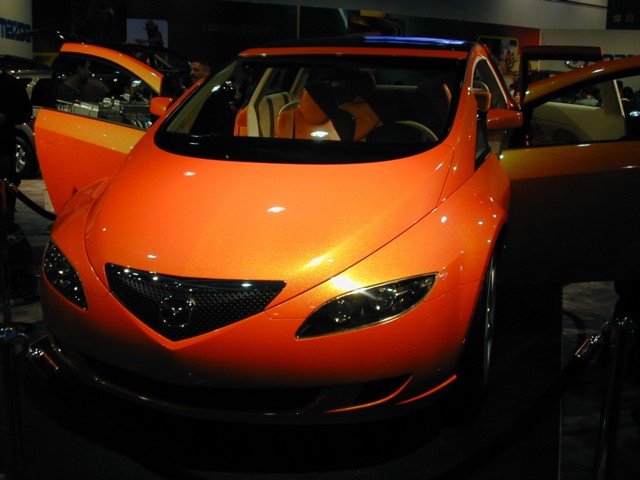
Mazda also displayed an alternative-powered concept vehicle, the MX Sport Tourer; this has an internal-combustion engine with an Integrated Starter and Generator (ISG) similar to the arrangement in the Honda Insight and Toyota Prius hybrids. However, instead of having the electric-drive function built into the ISG like these cars, the MX Sport Tourer has a separate electric motor driving the rear wheels.
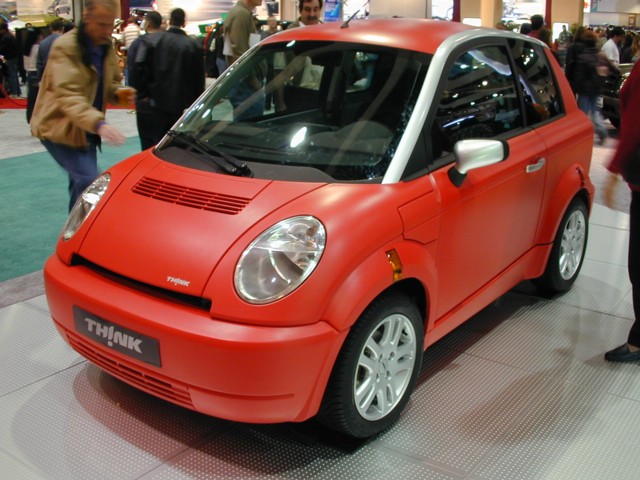
There was a display from TH!NK in the main Ford area; this is the company's division that focuses on small electric vehicles and (as we'll see below) on fuel-cell vehicles. (The Global Electric MotorCars (GEM) vehicles from DaimlerChrysler were also on display in their areas, as at the recent Anaheim Auto show.) TH!NK has had two models of electric bicycles in production for a year or so, and recently began production of the TH!NK Neighbor LSV (a Low-Speed Vehicle, with top speed of 25 MPH, is legal in many states on streets with speed limits of 35 MPH or less); pictured here is the production model of the TH!NK City, an "urban electric vehicle" designed for commuting and errands. It's a freeway-capable two-seater that can go about 60 miles around town on a single charge--plenty for the vast majority of driving. This evolved from the City Bee made by PIVCO, a Norwegian company bought out by Ford a few years back; in preparation for a launch in the U.S. in Fall 2002, TH!NK added some amenities like power steering and air conditioning, and changed the rather toy-like "as-cast" thermoplastic body on the prototypes into a smoother finish as you see here. The vehicle is expected to list for about $20,000, minus any incentives you can dig up (I don't yet know if it will be eligible for the big California rebates); I have read estimates that this price could be cut in half if production reached a rather modest three hundred thousand per year or so.
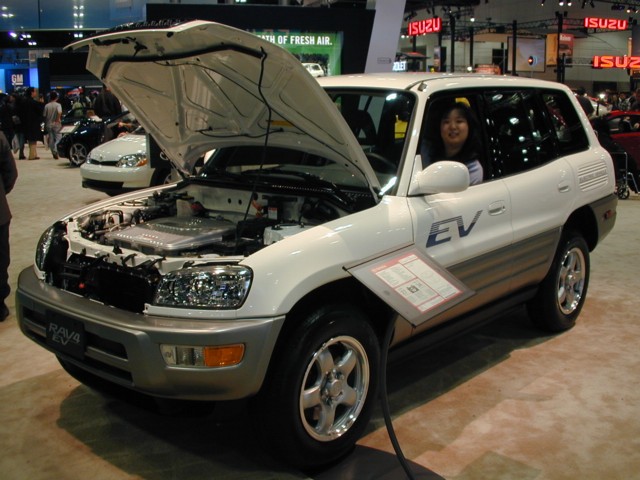
I have never been able to establish whether private consumers were ever allowed to buy, as opposed to lease, the Ford Ranger electric pickup truck; certainly the GM EV1 and Honda EV Plus were only available for lease. The Toyota RAV4-EV electric compact sport-utility vehicle has been sold to fleets for a couple of years, and as of February 2002 it will be available to the general public as well for purchase or lease. This is, then, probably the first EV ever offered for sale to the public; I have been waiting to buy an EV since the GM Impact prototype car was rolled out in 1990, so I am very happy to see this development! That's my wife Cheryl in the driver's seat; we don't have any kids yet, but a five-seat compact SUV, without the step up into my van or the step down into her Saturn, would make a nice family car...
Actually, the Toyota folks on hand told me that they are recommending that customers lease rather than buy the vehicle, for two reasons. First, the nickel metal-hydride (NiMH) battery pack still costs an awful lot; the vehicle is for sale at $42,000 (though incentive money in California pulls that down to $30,000), but if the battery pack needs replacing out of warranty it will cost $30,000, almost as much as the whole vehicle! So, although NiMH batteries live a lot longer than lead-acid batteries, and I have heard claims that they are true "life of the vehicle" components, Toyota still suggests that you lease a RAV4-EV for no more than the duration of the 5-year, 60,000-mile warranty. Second, the battle between conductive and inductive recharging standards is about to take a major turn, with the California Air Resources Board preparing to get all automakers to change over to conductive charging (joining Ford and Honda, who have used it all along) by the 2007 model year. GM and Toyota have backed the inductive standard, so while buyers of the RAV4-EV will be able to use an inductive charger in their homes (supplied with the vehicle) to charge up overnight for as long as they own the vehicle, it will probably become more difficult to find public recharging sites for inductive vehicles in a few years. By 2007, Toyota expects to phase out the RAV4-EV and introduce new vehicles that use conductive chargers; it's clear that they intend the RAV4-EV to be a temporary measure (those familiar with current Toyota models will note that the 2002 RAV4-EV pictured is based on the 2000 RAV4, not the revised 2001-2002 models--this may be a further sign that Toyota isn't interested in spending much development resources on the RAV4-EV). That's too bad; Cheryl and I like the vehicle, and we'll keep it in mind, though it would mean walking away from the large amount of GM Card rebate bucks that I'd piled up in the hope that I'd be able to use them to buy an EV1 years ago!
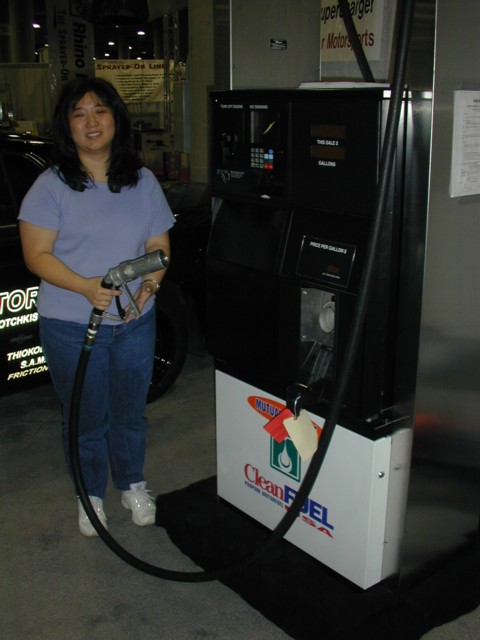
We had just a few hours at the Auto Show, and we found some of the most interesting displays away from the main halls, in the area with the specialty-equipment vendors, during the last hour we spent at the show! We met Scott Alder of Scott Alder Motorsports, an automotive prototype and R&D house from our hometown of Redondo Beach, who was showing a baaaad-for-your-eyes black Ford Crown Victoria with a supercharged V-10 engine running on liquefied petroleum gas (LPG, or propane), based on Ford's heavy-duty LPG truck engine. In front of the car in this photo is Cheryl holding the nozzle of a new LPG dispenser from Clean Fueling Technologies, which is being deployed by a consortium called CleanFUEL USA in several western states. This is the first modern LPG dispenser I've seen; Cheryl is very tolerant to put up with the way I get excited about fuel pumps and the like! It is, I understand, compatible both with new factory-installed fueling systems and with older-style tank inlets that have been installed on converted gasoline vehicles for years.
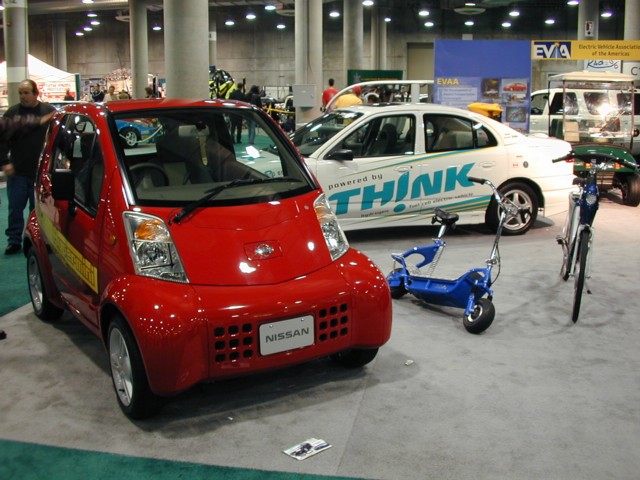
Then in the last fifteen minutes or so before the show closed that day, we ran into a sizable area of electric, hybrid, and fuel-cell vehicles, manned by volunteers from the Electric Vehicle Association of the Americas (EVAA). There were electric scooters and bicycles from a variety of makers, including ZAP and rad2go, neighborhood electric vehicles like the TH!NK Neighbor, and quite a lot of urban EVs and full-size vehicles. In the foreground of this photo is the Nissan Hypermini urban EV, and an earlier version of the TH!NK City was there too; behind the Hypermini is the Ford P2000 fuel-cell prototype. Ford is planning to introduce a fuel-cell version of the Focus in small numbers for the 2004 model year; the previous year will see the introduction of the hybrid version of their Escape small SUV, in the background of this photo under the EVAA banner. Not visible here are the Honda Insight, the RAV4-EV, and Sequoia, a Chevy Suburban hybrid-electric vehicle (running off a 1.9-liter Saturn engine!) built for the Future Truck competition by the UC Davis Hybrid Electric Vehicle Research Program team, who described it to me when I met them at the ZEVent in 2000.
Reviewing what I wrote for the recent Anaheim Auto Show, I guess I sounded pretty discouraged. Part of that was because this was the first auto show I'd attended in five years or so where I didn't find my old friend the EV1 on display in the Saturn area. But after seeing such a variety of vehicles at this show, and particularly the battery-electric and fuel-cell vehicles that have near-term production and sales plans, I still have hope that I won't have to give the lie to the bumper sticker on the back of my natural-gas van that says "My Next Car Will Be A Zero-Emission Vehicle!"
 Back
to AFV Events Page
Back
to AFV Events Page Back
to Fueling Station
Back
to Fueling Station Site
Map
Site
Map Contact
Me
Contact
Me All content copyright 1998-2024 by Mark Looper, except as noted. Reuse of my copyrighted material is authorized under Creative Commons Attribution 4.0 International license (CC BY 4.0).
![]()
![]()
new 12 January 2002